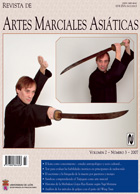Desarrollo de un test para evaluar las habilidades motrices en principiantes de taekwondo
DOI:
https://doi.org/10.18002/rama.v2i3.317Resumo
Não há resumo disponível em Português
Downloads
Métricas alternativas
Referências
ABRAHAM, C., DYSON, R. & KINGMAN, J. (2001). Muscular activity of the striking leg during the martial arts front, side and turning kicks. Journal of Sports Sciences, 19, 3-84.
AMPONGAN, C. & PIETER, W. (2005). Competition anxiety in elite Filipino taekwondo athletes. Acta Kinesiologiae Universitatis Tartuensis, 10: 7-17.
BARROW, H. & MCGEE, R. (1971). Measurement in physical education. Philadelphia: Lea & Febiger.
BARROW, H., MCGEE, R. & TRITSCHLER, K. (1989). Practical measurement in physical education and sport. Philadelphia: Lea & Febiger.
BAUMGARTNER, T. & JACKSON, A. (1995). Measurement for evaluation in physical education and exercise science. Dubuque, IA: Brown & Benchmark Publishers.
BRONKHORST, H., LEMMINK, K. & VISSCHER, C. (1998). Lichamelijk prestatievermogen van judoka’s (Physical performance capacity of judoka). Groningen: Olympisch Steunpunt Noord Nederland.
CHAN, K., PIETER, W. & MOLONEY, K. (2003). Kinanthropometric profile of recreational taekwondo athletes. Biology of Sport, 20(3): 175-179.
HEIJMANS, J. & PIETER, W. (1989). Verschillen in maximaal moment van mannelijke en vrouwelijke vechtsporters (Gender differences in peak torque of elite martial arts athletes). Sportmedische Tijdingen, 11(41): 95-101.
HWANG, I. (1987). Analysis of the kicking leg in taekwondo. In J. Terrauds, B. Gowizke, & L. Holt (Eds.), Biomechanics in Sports III & IV. Proceedings of ISBS (pp. 39-47). Del Mar, CA: Academic Publishers.
KERR, R. (1982). Psychomotor learning. Philadelphia: Saunders College Publishing.
LEHMANN, G., MOSCH, N. & LILGE, W. (1994). Untersuchungen zur Struktur der Leistungsvoraussetzungen des taekwondokämpfers (Investigation of the structure of performance correlates in taekwondo fighters). Leistungssport, 24(3): 21- 26.
LIDOR, R., MELNIK, Y., BILKEVITZ, A., ARNON, M. & FALK, B. (2005). Measurement of talent in judo using a unique, judo-specific ability test. Journal of Sports Medicine and Physical Fitness, 45(1): 32-37.
MIETH, R. (1981). Development of a motor skill test for judoists aged 9-14. En H. Haag, D. Kayser, & B. Bennett (Eds.), Physical Education and Evaluation, Proceedings of the XXII ICHPER World Congress (pp. 23-27). Schorndorf: Verlag Karl Hofmann.
MIN, K. (Ed.) (1975). The national collegiate taekwondo, karate, kung-fu handbook. Berkeley, CA: American Collegiate Taekwondo Coaches Association.
MIN, K. (1979). Martial arts in the American educational setting. Quest, 31(1): 97- 106.
NISTICO, V. P. (1982). A kinematic investigation of two performance conditions of the karate counter-punch technique. Unpublished Master’s thesis, University of Oregon.
PIETER, W. (1987). Angst bij vechtsport (Anxiety in martial sports). Sport-Gericht, 9 (3): 109-112.
PIETER, W. (1991). Performance characteristics of elite taekwondo athletes. Korean Journal of Sport Science, 3: 94-117.
PIETER, W. (1986). Zwarte band taekwondo (The black belt holder in taekwondo), Sport-Gericht, 8(1): 37-39.
PIETER, W. & HEIJMANS, J. (2000). Scientific coaching for Olympic taekwondo. Aachen: Meyer & Meyer Verlag.
PIETER, W. & KIM, G. D. (2004). Performance markers and sidedness in female elite taekwondo athletes: a pilot study. Acta Kinesiologiae Universitatis Tartuensis, 9: 37-44.
PIETER, W. & TAAFFE, D. (1992). The Oregon Taekwondo Research Project: results and recommendations, Journal of Asian Martial Arts, 1(1): 73-85.
PIETER, W., TAAFFE, D., TROXEL, R. & HEIJMANS, J. (1989). Isokinetic peak torque of the quadriceps and hamstrings of college age taekwondo athletes. Journal of Human Movement Studies, 16(1): 17-25.
PIETER, W., VAN RYSSEGEM, G., LUFTING, R. & HEIJMANS, J. (1995). Injury situation and injury mechanism at the 1993 European Taekwondo Cup. Journal of Human Movement Studies, 28(1): 1-24.
PIETER, W. & ZEMPER, E. D. (1997). Injury rates in children participating in taekwondo competition. The Journal of Trauma, 43(1): 89-95.
SAFRIT, M. & WOOD, T. (1995). Introduction to measurement in physical education and exercise science. London: Mosby.
SCHMIDT, R. (1991). Motor learning and performance. Champaign, IL: Human Kinetics Books.
STEPHENSON, D. & JACKSON, A. (1977). The effects of training and position on judges’ ratings of a gymnastic event. Research Quarterly, 48(1): 177-180.
TAAFFE, D. & PIETER, W. (1990). Physical and physiological characteristics of elite taekwondo athletes (pp. 80-88). En Commonwealth and International Conference Proceedings. Volume 3. Sport Science. Part 1. Auckland, New Zealand: NZAHPER.
Downloads
Publicado
Como Citar
Edição
Secção
Licença
Direitos de Autor (c) 2012 Willy Pieter, John Heijmans

Este trabalho encontra-se publicado com a Licença Internacional Creative Commons Atribuição-NãoComercial-CompartilhaIgual 4.0.
Os autores que publicam nesta Revista estão de acordo com os seguintes termos:
- Os autores cedem, de forma exclusiva, os direitos de exploração (reprodução, distribuição, comunicação pública, transformação) à Universidade de Léon, podendo estabelecer, em separado, acordos adicionais para a distribuição não exclusiva da versão do artigo publicado na Revista (por exemplo: alojar no repertório institucional ou publicá-lo num livro), com o reconhecimento da publicação inicial nesta Revista.
- O trabalho encontra-se na Creative Commons Attribution-Non Commercial-Share Alike 4.0 International License. Pode-se consultar aqui o resumo e o texto legal da licença.
- Permite-se, e sugere-se, que os autores difundam electronicamente as versões pré-impressão (versão antes de ser avaliada) e pós-impressão (versão avaliada e aceite para publicação das suas obras antes da sua publicação), favorecendo a sua circulação e difusão, e com ela o possível aumento da sua citação e alcance pela comunidade académica.











